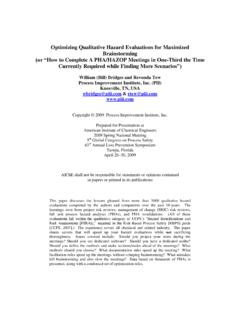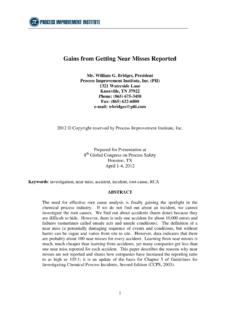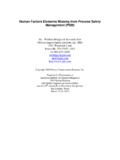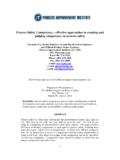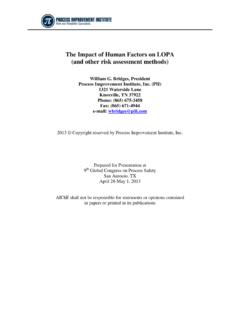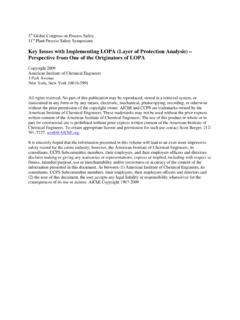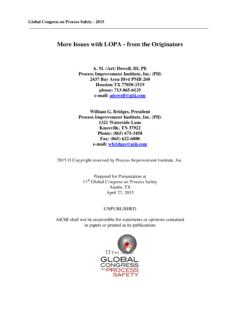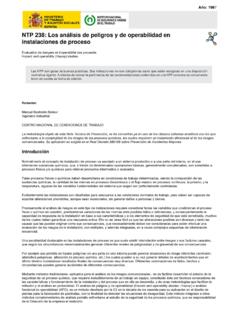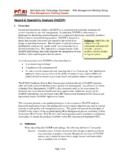Transcription of Selection of Hazard Evaluation Techniques
1 1 Root Cause Analysis,InvestigationUnderstand Human Error PHA, RCM, JSAM anagement Systems to Control Human ErrorSustainable Control of Human Error (Human Reliability)Controlling RiskBehavior Man. Traditional HSETQM & Safety StandardsImplementation LevelManagement System LevelBehavior/Habit ControlProcedures & TrainingProcess/SystemDesignHazardEvalua tionSelection of Hazard Evaluation Techniques William Bridges Process Improvement Institute, Inc. (PII) 1321 Waterside Lane Knoxville, TN 37922 USA +1-865-675-3458 Copyright 2008 Process Improvement Institute, Inc. Paper first presented at ASSE Middle East Chapter Conference, February, 2008 Bahrain The ability to ensure process safety at a facility is influenced by many things: for example, employing appropriate technology in design and construction, anticipating the effects of external circumstances, understanding and dealing with human behavior, getting high reporting of near misses to learn from incidents, and having effective management systems.
2 However, all of these efforts depend on a successful Hazard Evaluation program; without these evaluations, the company will not know what layers of protection are needed. Process Improvement Institute, Inc. (USA; 2004) 2 A successful Hazard Evaluation program requires tangible management support; sufficient, technically competent people (some of whom must be trained to use Hazard Evaluation Techniques ); adequate, up-to-date information and drawings; and Selection of the Techniques (matched to the complexity and Hazard of the process). Fortunately, a variety of flexible Hazard Evaluation Techniques exist.
3 Below is a simple listing of generally accepted Techniques : Qualitative Techniques : These methods help a multi-disciplinary team (1) identify potential accident scenarios and (2) evaluate the scenario in sufficient detail to make a reasonable judgment of risk. If the team is confused on the risk, a scenario identified in a qualitative Hazard review may be further analyzed using one or more of the quantitative Techniques . Preliminary Hazard Analysis (PreHA): A technique that is derived from the Military Standard System Safety Program Requirements. The Preliminary Hazard Analysis is often used to evaluate hazards early in the life of a process.
4 A Preliminary Hazard Analysis is generally applied during the conceptual design or R&D phase of a process plant and can be very useful when making site Selection decisions. It is also commonly used as a design review tool before a process P&ID is developed Checklist (traditional): A detailed list of desired system attributes or steps for a system or operator to perform. Usually written from experience and used to assess the acceptability or status of the system or operation compared to established norms. What-If Analysis: A brainstorming approach in which a group of experienced people familiar with the subject process ask questions or voice concerns about possible undesired events.
5 The method does not use guide words to help in the brainstorming. What-If/Checklist Analysis: A brainstorming approach in which a group of experienced people familiar with the subject process ask questions or voice concerns about possible undesired events. The method is similar to What-if alone, with the difference being that broad categories of types of concerns are used to structure the analysis. 2 Guide Word Analysis: A systematic method in which potential operating problems are identified by asking what would happen is a step in a procedure were (1) skipped or (2) performed incorrectly. This method is applicable to any procedure (startup, shutdown, online maintenance, or normal batch operations), but does not apply to continuous operating mode.
6 Hazard and Operability (HAZOP) Analysis: A systematic method in which potential operating problems are identified using a series of guide words to investigate process deviations. Can be applied to any mode of operation of a flow process and can also be applied to any procedure or flowchart. Failure Modes and Effects Analysis (FMEA): A systematic, tabular method for evaluating and documenting the effects of known types of component failures. Applies to electrical/mechanical systems. Can also be applied to flow systems where very high reliability factors are needed (such as fire-fighting water supply systems).
7 3 Quantitative Techniques : These do not identify possible accident scenarios, but they instead aid in risk judgment by provide more detailed, statistical evaluations of the risk of a specific scenario. Layer of Protection Analysis (LOPA): A method that uses pre-defined values for initiating events, independent protection layers, and consequences to provide an order-of-magnitude estimate of risk. LOPA applies to a single cause-consequence pair. Scenarios are identified elsewhere (typically in a qualitative Hazard Evaluation ). Dow Fire and Explosion Index (F&EI): A method, developed by Dow Chemical Company, for ranking the relative potential fire and explosion risk effect radius and property damage/business interruption impacts associated with a process.
8 Analysts calculate various Hazard and exposure indexes using material characteristics and process data. Dow Chemical Exposure Index (CEI): Address five types of factors that can influence the effects of release of the material: (1) acute toxicity, (2) volatile portion of material which could be released, (3) distance to areas of concern, (4) molecular weight of the substance, and (5) various process parameters such as temperature, pressure, reactivity, and so forth. The CEI is the product of values assigned for each of the factors of concern using arbitrarily defined numerical scales. Fault Tree Analysis (FTA): A logic model that graphically portrays the combinations of failures that can lead to a specific main failure or incident of interest (Top event).
9 This method using Boolean Logic (And & Or logic gates). Assigning statistical values to each end point on a branch allows the calculation of risk. Event Tree Analysis (ETA): A logic model that graphically portrays the combinations of events and circumstances in an incident sequence. Assigning statistical values to each branch point (failure or condition) allows the calculation of composite risk starting from a defined initiating event. Human Reliability Analysis (HRA) event tree: A graphical model of sequential events in which the tree limbs designate human actions and other events as well as different conditions or influences upon these events.
10 Assigning statistical values to each branch point (correct or incorrect performance of a step) allows the calculation of composite risk starting from a defined first step. What What If AnalysisIf AnalysisChecklists AnalysisChecklists AnalysisHAZOPHAZOPFMEAFMEALOPALOPAF ault Tree AnalysisFault Tree AnalysisEvent Tree AnalysisEvent Tree AnalysisIncludes Includes Consequence Consequence ModelingModelingIncludes Includes Consequence Consequence CategorizationCategorizationUses Uses voting voting and and fuzzy fuzzy logic to logic to score score riskriskBrain storming (finds Brain storming (finds the problems)the problems)
